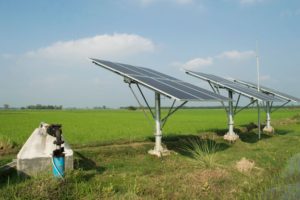Published on: September 28, 2021
PM KUSUM
PM KUSUM
What is in news :The Union Minister of Power, New and Renewable Energy recently reviewed the progress of the PM-KUSUM scheme and reaffirmed the government’s commitment to accelerating solar pump adoption
About PM KUSUM
- Full Form – Kisan Urja Suraksha evam Utthaan Mahabhiyan
- Implemented by – The New and Renewable Energy Ministry.
- The approved scheme comprises of three components:
- setting up of 10,000 MW of decentralised ground / stilt-mounted grid-connected solar or other renewable energy based power plants
- installation of 17.5 lakh standalone solar agriculture pumps
- solarisation of 10 lakh grid-connected solar agriculture pumps
- Benefits: It would provide extra income to farmers, by giving them an option to sell additional power to the grid through solar power projects set up on their barren lands. It would help in de-dieselising the sector as also the DISCOMS.
- Significance: Expected positive outcomes of the scheme include promotion of decentralised solar power production, reduction of transmission losses as well as providing support to the financial health of DISCOMs by reducing the subsidy burden to the agriculture sector. The scheme would also promote energy efficiency and water conservation and provide water security to farmers.
CHALLENGES & WAY FORWARD
- Extend the scheme’s timelines. Most Indian discoms have a surplus of contracted generation capacity and are wary of procuring more power in the short term. Extending PM-KUSUM’s timelines beyond 2022 would allow discoms to align the scheme with their power purchase planning.
- Create a level playing field for distributed solar plants. Selling surplus power to discoms is one of the main attractions of grid-connected models. Yet, discoms often find utility-scale solar cheaper than distributed solar (under the scheme) due to the latter’s higher costs and the loss of locational advantage due to waived inter-State transmission system (ISTS) charges. To tackle the bias against distributed solar, we need to address counter-party risks and grid-unavailability risks at distribution substations, standardise tariff determination to reflect the higher costs of distributed power plants, and do away with the waiver of ISTS charges for solar plants.
- Streamline land regulations through inter-departmental coordination. Doing so will help reduce delays in leasing or converting agricultural lands for non-agricultural purposes such as solar power generation.
- Support innovative solutions for financing farmers’ contributions. Many farmers struggle to pay 30-40% of upfront costs in compliance with scheme requirements. Further, they cannot access bank loans without collateral. We need out-of-the-box solutions like Karnataka’s pilot of a farmer-developer special-purpose vehicle to help farmers install solar power plants on their farms.
- Extensively pilot grid-connected solar pumps. Current obstacles to their adoption include concerns about their economic viability in the presence of high farm subsidies and farmers’ potential unwillingness to feed in surplus power when selling water or irrigating extra land are more attractive prospects. Further, the grid-connected model requires pumps to be metered and billed for accounting purposes but suffers from a lack of trust between farmers and discoms. Adopting solutions like smart meters and smart transformers and engaging with farmers can build trust. But piloting the model under different agro-economic contexts will be critical to developing a strategy to scale it up.The scheme, if implemented successfully, can generate thousands of jobs, reduce the carbon footprint of agriculture, and result in oil import savings.

